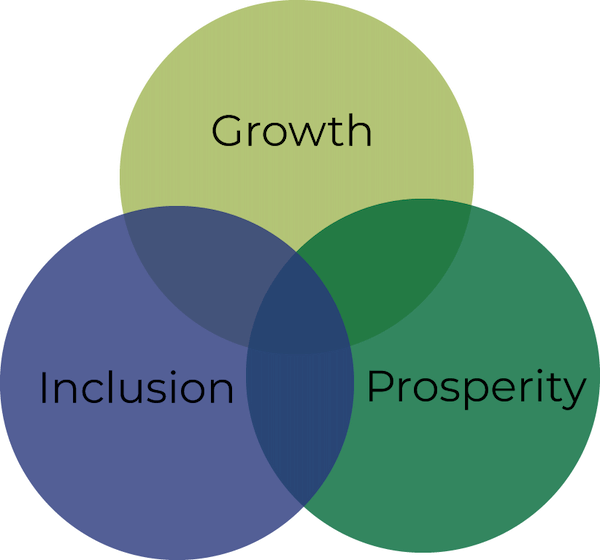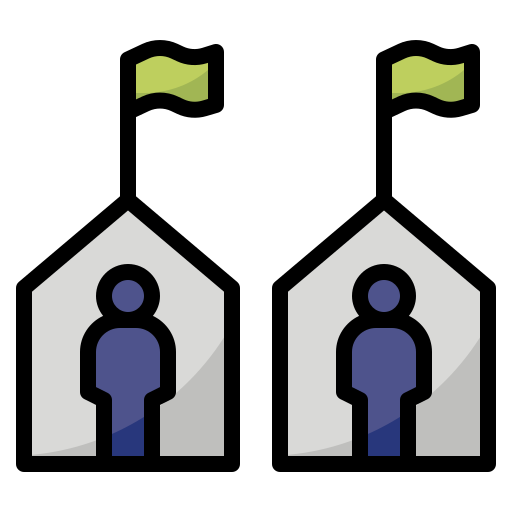Some challenges must be addressed by combining the resources and knowledge of different organizations and people. New programs are creates as a collaboration between institutions and organizations. Advance Longmont 1.0, our first economic development strategy, called for the Advance Longmont Partners – a roundtable of local institutions to improve collaboration – and saw dozens of successes.
We envision an economy powered by the engines of growth, creating shared prosperity for families, and building opportunity and community wealth for all of Longmont.
Our Vision for Longmont's Economy
A foundation built around growth, prosperity, and inclusion.

Growth
The Engine of Economic Success
The engines of growth are powerful. Growth is the standard toolbox for economic developers: it shows that the region, on aggregate, is better-off than the previous year. Growth indicates that small and large businesses are selling goods, investors are financing new projects, and a region is providing more opportunities for individuals and families. A growing economy usually indicates more employment opportunities, increased sales and revenue, more foreign exports, and growing earnings for workers.


Prosperity
A Rising Tide for All Boats
Growth in overall output or other measures of the standard toolbox doesn’t mean those gains are shared equally among workers or families. Growth in a region may also come with increased cost-of-living that diminishes the real earnings of families. Prosperity examines this second key component: to what degree are those gains in growth shared equally among workers and families in our community? Increasing prosperity means real improvements in the standards of living and income for families and individuals.
Inclusion
Building Community Wealth and Opportunity
While growth and prosperity are integral to succeeding our vision, inclusion embeds a third crucial component: addressing marginalization and economic exclusion. Inclusive growth – or more generally, an inclusive economy – ensures that real opportunities are being shared across racial and ethnic groups. It also focuses on building community wealth and economic opportunity in neighborhoods and places that have historically lacked them. Increasing inclusion means closing income and wealth disparities within our community.

Economic development hasn't always been equipped to achieve this vision.
Here's a brief history of where economic development has been.

Traditional economic development focuses on
Primary Industry Development
Economic development began as primary industry development. Primary employers – both big and small – earn most of their revenue from outside the region, but pay their employees with that revenue. This creates a new source for spending and saving in a local economy. With the recognition that primary industry contributes substantially to the economic health of a community, economic developers use marketing campaigns and policy tools to attract and retain primary employers.
Some communities focus on
Entrepreneurial Development
The success of Silicon Valley as a global entrepreneurial hub sparked the interest of many urban centers to create their own entrepreneurial ecosystem. Between focusing on high-growth scalable startups (future primary employers) and local businesses, communities can grow their own success.


Building vibrant local economies through
Placemaking
Place matters. The regeneration of many urban centers after decades of decline fueled this recognition. By focusing on human-scale design and making central areas pedestrian friendly, encouraging mixed-use development, preserving green space, and other place-based initiatives, local businesses thrive in healthy and happy places.
Solving specific local economic problems with
Collaboration

We're advancing the next evolution of economic development: collective impact.

Collective impact aligns organizations, people, and resources to implement what matters.
Of all of the three components, growth is the easiest to achieve as a silo. Very little cross-community work is necessary to grow revenue or employment. Traditional economic development tools are well-equipped to address the challenges and opportunities of growth.
Yet, achieving prosperity and inclusion requires new levels of cross-community alignment. Organizations must work together to address these systemic challenges by re-orienting the entire community system. Collective impact invites us to transform how our community works together to address our shared challenges. This powerful framework improves communication, alignment, and institutional knowledge between private, public, and non-profit partners in our community. It also creates and deploys innovative projects that accelerate community and economic impact. Collective impact is our opportunity to develop a local economy with a strong foundation in growth, prosperity, and inclusion.
